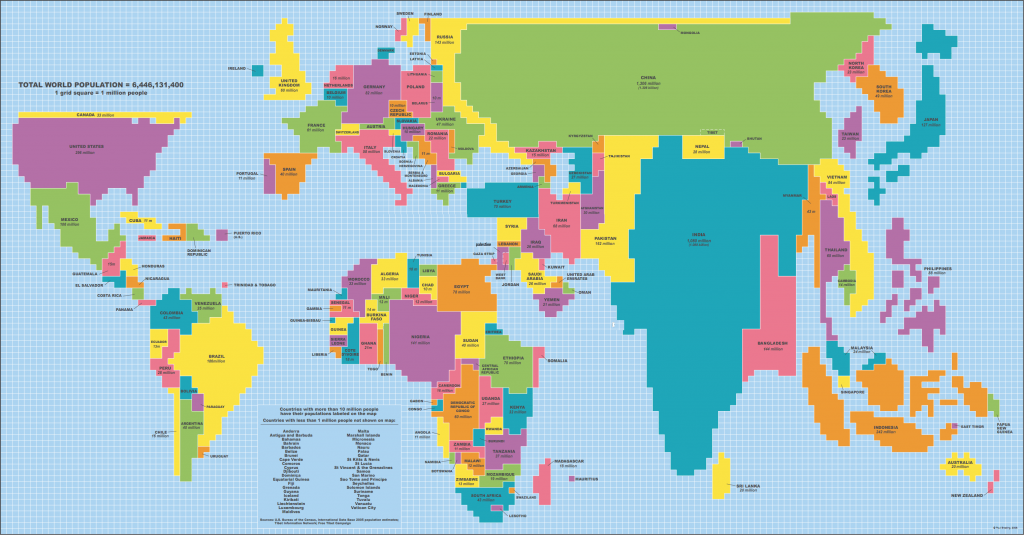This column was published by The Myanmar Times on Monday, 3 August 2015
There is a map of the world I really like that calibrates population with country size (see here). It profoundly re-shapes how we might think about the world and its future.
On such a map, China and India balloon. A few countries in Africa and across Asia match their heavy population densities. Bangladesh and Indonesia, as two regional examples, also take on extra significance in such a presentation.
A few weeks back, I had the honour to lecture at the University of Yangon. In seeking to make my points to a tremendously well-informed group of graduate students, I used plenty of maps and photographs, including one of these population-oriented illustrations of the world.
After asking the class to point out Myanmar, there was no hiding from the implications for the future of this country’s 52 million people. Wedged between the billion-plus behemoths of China and India, and nestled against the other 550 million people of Southeast Asia, Myanmar is right at the centre of a very crowded neighbourhood.
On this map, my own country of Australia almost disappears, its 23 million people struggling to fill a vast continent at the southern edge of Asia. And while Australians may talk as though the “Asian Century” requires their involvement, it is a country like Myanmar that is on the frontline.
What might its challenges be?
To begin with, there will be the competition between Chinese and Indian visions for their shared region. Already this is playing out in the Bay of Bengal and through their jousting for influence around the Strait of Malacca.
Myanmar will struggle to balance Indian and Chinese demands, which require tough decisions about what happens next.
Some of those decisions will be about population movement. Myanmar has already absorbed more than 2 million ethnic Chinese, and in living memory there were similarly large populations of Indians residing in the country.
Today’s popular antagonism toward the Rohingya and other Muslim populations can be explained as part of a very old effort to police the boundaries of belonging. For now, the Chinese appear to have found themselves in a relatively comfortable spot.
Yet how long can that last? Earlier in the year, rumblings about Chinese support for the ethnic Kokang rebels in northern Shan State threatened to ignite some of the anti-Chinese sentiments that often lurk just out of view.
Myanmar does not have the luxury of a stoush with China, or with India, and probably can’t afford to get too heavily caught up in their efforts to re-jig the regional order. Myanmar currently looks for external support, particularly to ASEAN and the western democracies, but this may not be a permanent solution.
Instead, Myanmar will need to find sufficient wriggle room of its own to ensure that it does not end up getting squashed between Asia’s giants.
Managed well, there is certainly a chance for Myanmar to build its economy on the basis that it is one of the few countries that enjoys borders with both India and China. The others are Bhutan, Nepal and Pakistan. Of these four, it is fair to say that Myanmar has the greatest inheritance of geographic opportunity.
Its coastlines are long, its mountains more-or-less navigable and its people relatively comfortable with absorbing influences from both the east and the west. Land-locked Himalayan nations, like those of Nepal and Bhutan, must look on enviously as Myanmar seeks to capitalise on its good fortune.
It will take savvy on the part of Myanmar’s leadership to really make the most of what this location means.
It will also require the prudent use of scarce diplomatic resources to protect Myanmar interests, develop the country’s own resources and improve the lives of its people throughout the potentially troubling decades to come.
For Myanmar, the development of a strategy that helps to maximise the opportunities of its location should be a high priority for the new government. Senior officials need to be spending quality time with their Chinese and Indian counterparts, in the hope that familiarity breeds new appreciation on all sides.
If everything goes according to plan, there will probably be a chance in 2016 for many of the world’s leaders to visit Myanmar and welcome the new government with applause. In the front row, Prime Minister Narendra Modi and President Xi Jinping should be encouraged to take a second look at Myanmar.
Ideally, they will find a long-term partner that is creating its own realistic model for doing business and creating a stable political system. This will earn their respect and may also encourage the two Asian giants to consider how their joint interests can be pursued through Myanmar facilitation.
In the long term, Myanmar could be the linchpin for the security and prosperity of hundreds of millions of people well beyond its borders. But this will require smart planning and wise judgment – in foreign affairs, geography comes first.
Nicholas Farrelly is co-founder of New Mandala and Director of the Australian National University’s Myanmar Research Centre.
 Facebook
Facebook  Twitter
Twitter  Soundcloud
Soundcloud  Youtube
Youtube  Rss
Rss 
